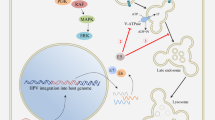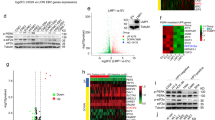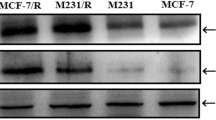Abstract
High-risk human papillomavirus (hr-HPV) E6 and E7 oncogenes are associated with resistance to radiotherapy in cervical cancer. Efforts have been taken to employ HPV E2, a crucial negative transcriptional modulator of HPV E6 and E7 oncogenes, and also an apoptosis-inducing agent, for therapeutic intervention. Despite being conceptually attractive, the potency and feasibility of current hr-HPV E2-based therapies remain limited. Here, we designed a novel recombinant adenovirus, named M5, with a 27-bp deletion in E1A conserved region-2 by which to realize tumor-specific replication, and a total HPV type 16 (HPV16) E2 gene complementary DNA inserted into the E3 coding region. In this design, M5 exploited the adenovirus E3 promoters to express HPV16 E2 gene in a viral replication-dependent manner and preferentially silenced the hr-HPV E6 and E7 oncogenes in HPV-positive cervical cancer cells. In vitro and in vivo assays confirmed that M5 exhibited potent antitumoral efficacy. Moreover, the effects of combined treatment with M5 and radiation treatment resulted in synergistically enhanced potency (P<0.01). The increase in killing efficacy of M5 was also found in HPV-negative cervical cancer cells, for which the pro-apoptotic activity of HPV16 E2 was thus responsible. Our results indicated that the use of M5 that locally delivers HPV16 E2 to cancers has broad therapeutic windows and that the combination therapy with radiation for cervical cancer will be the more effective way of improving survival.
This is a preview of subscription content, access via your institution
Access options
Subscribe to this journal
Receive 12 print issues and online access
$259.00 per year
only $21.58 per issue
Buy this article
- Purchase on Springer Link
- Instant access to full article PDF
Prices may be subject to local taxes which are calculated during checkout






Similar content being viewed by others
References
Waqqoner SE . Cervical cancer. Lancet 2003; 361: 2217–2225.
Petignat P, Roy M . Diagnosis and management of cervical cancer. BMJ 2007; 335: 765–768.
Stewart AJ, Viswanathan AN . Current controversies in high-dose-rate versus low-dose- rate brachytherapy for cervical cancer. Cancer 2006; 107: 908–915.
Bhosle SM, Huilgol NG, Mishra KP . Programmed cell death as a prognostic indicator for radiation therapy in cervical carcinoma patients: a pilot study. J Cancer Res Ther 2005; 1: 41–45.
Heikaus S, Kempf T, Mahotka C, Gabbert HE, Ramp U . Caspase-8 and its inhibitors in RCCs in vivo: the prominent role of ARC. Apoptosis 2008; 13: 938–949.
Bosch FX, Lorincz A, Munoz N, Meijer CJ, Shah KV . The causal relation between human papillomavirus and cervical cancer. J Clin Pathol 2002; 55: 244–265.
Werness BA, Levine AJ, Howley PM . Association of human papillomavirus types 16 and 18 E6 proteins with P53. Science 1990; 248: 76–79.
Dyson N, Howley PM, Munger K, Harlow E . The human papillomavirus 16-E7 oncoprotein is able to bind to the retinoblastoma gene product. Science 1989; 243: 934–937.
Santin AD, Hermonat PL, Ravaggi A, Chiriva-Internati M, Pecorelli S, Parham GP . Radiation-enhanced expression of E6/E7 transforming oncogenes of human papillomavirus-16 in human cervical carcinoma. Cancer 1998; 83: 2346–2352.
Antson AA, Burns JE, Moroz OV, Scott DJ, Sanders CM, Bronstein IB et al. Structure of the intact transactivation domain of the human papillomavirus E2 protein. Nature 2000; 403: 805–809.
Webster K, Parish J, Pandya M, Stern PL, Clarke AR, Gaston K . The human papillomavirus (HPV) 16 E2 protein induces apoptosis in the absence of other HPV proteins and via a p53-dependent pathway. J Biol Chem 2000; 275: 87–94.
Demeret C, Garcia-Carranca A, Thierry F . Transcription independent triggering of the extrinsic pathway of apoptosis by human papillomavirus 18 E2 protein. Oncogene 2003; 22: 168–175.
Blachon S, Demeret C . The regulatory E2 proteins of human genital papilloma-viruses are pro-apoptotic. Biochimie 2003; 85: 813–819.
Heise C, Kirn D . Replication-selective adenoviruses as oncolytic agents. J Clin Invest 2000; 105: 847–851.
Yu D-C, Working P, Ando D . Selectively replicating oncolytic adenoviruses as cancer therapeutics. Curr Opin Mol Therap 2002; 4: 435–443.
Bischoff J, Kirn D, Williams A, Heise C, Horn S, Muna M et al. An adenovirus mutant that replicates selectively in p53-deficient human tumor cells. Science 1996; 274: 373–376.
Hay J, Shapiro N, Sauthoff H, Heitner S, Phupakdi W, Rom W . Targeting the replication of adenoviral gene therapy vectors to lung cancer cells: the importance of the adenoviral E1b-55 kD gene. Hum Gene Ther 1999; 10: 579–590.
Heise C, Hermiston T, Johnson L, Brooks G, Sampson-Johannes A, Williams A et al. An adenovirus E1A mutant that demonstrates potent and selective systemic anti-tumoral efficacy. Nat Med 2000; 6: 1134–1139.
Kirn D, Heise C, Williams M, Propst M, Hermiston T . Adenovirus E1A CR2 mutants as selectively-replicating agents for cancer. Presented at Cancer Gene Therapy Meeting (R Sobol and K Scanlon, organizers). San Diego, CA, 1998.
Hawkins LK, Johnson L, Bauzon M, Nye JA, Castro D, Kitzes GA et al. Gene delivery from the E3 region of replicating human adenovirus: evaluation of the 6.7K/gp19K region. Gene Therapy 2001; 8: 1123–1131.
Chu RL, Post DE, Khuri FR, Van Meir EG . Use of replicating oncolytic adenoviruses in combination therapy for cancer. Clin Cancer Res 2004; 10: 5299–5312.
Zhou J, Gao Q, Chen G, Huang X, Lu Y, Li K et al. Novel oncolytic adenovirus selectively targets tumor-associated polo-like kinase 1 and tumor cell viability. Clin Cancer Res 2005; 11: 8431–8440.
Ma D, Gerard RD, Li XY, Alizadeh H, Niederkorn JY . Inhibition of metastasis of intraocular melanomas by adenovirus-mediated gene transfer of plasminogen activator inhibitor type1 (PAI-1) in an athymic mouse model. Blood 1997; 90: 2738–2746.
Zhou J, Gurates B, Yang S, Sebastian S, Bulun S . Malignant breast epithelial cells stimulate aromatase expression via promoter II in human adipose fibroblasts: an epithelial–stromal interaction in breast tumors mediated by CCAAT/enhancer binding protein beta. Cancer Res 2001; 61: 2328–2334.
Wang W, Wang S, Song XF, Sima N, Xu X, Luo A et al. The relationship between c-FLIP expression and human papillomavirus E2 gene disruption in cervical carcinogenesis. Gynecol Oncol 2007; 105: 571–577.
Bermúdez-Morales VH, Peralta-Zaragoza O, Guzmán-Olea E, García-Carrancá A, Bahena-Román M, Alcocer-González JM et al. HPV 16 E2 protein induces apoptosis in human and murine HPV 16 transformed epithelial cells and has antitumoral effects in vivo. Tumour Biol 2009; 30: 61–72.
Wang W, Fang Y, Sima N, Li Y, Li W, Li L et al. Triggering of death receptor signaling of apoptosis by human papillomavirus 16 E2 protein in cervical cancer cell lines is mediated by interaction with c-FLIP. Apoptosis 2011; 16: 55–66.
Tollefson AE, Scaria A, Saha SK, Wold WS . The 11 600-MW protein encoded by region E3 of adenovirus is expressed early but is greatly amplified at late stages of infection. J Virol 1992; 66: 3633–3642.
Doronin K, Toth K, Kuppuswamy M, Ward P, Tollefson AE, Wold WS . Tumor-specific, replication-competent adenovirus vectors overexpressing the adenovirus death protein. J Virol 2000; 74: 6147–6155.
Sima N, Wang W, Kong D, Deng D, Xu Q, Zhou J et al. RNA interference against HPV16 E7 oncogene leads to viral E6 and E7 suppression in cervical cancer cells and apoptosis via upregulation of Rb and p53. Apoptosis 2008; 13: 273–281.
Chiocca EA . Oncolytic viruses. Nat Rev Cancer 2002; 2: 938–950.
Hawkins LK, Lemoine NR, Kirn D . Oncolytic biotherapy: a novel therapeutic platform. Lancet Oncol 2002; 3: 17–26.
Wang W, Sima N, Kong D, Luo A, Gao Q, Liao S et al. Selective targeting of HPV-16 E6/E7 in cervical cancer cells with a potent oncolytic adenovirus and its enhanced effect with radiotherapy in vitro and in vivo. Cancer Lett 2010; 291: 67–75.
Post DE, Shim H, Toussaint-Smith E, Van Meir EG . Cancer scene investigation: how a cold virus became a tumor killer. Fut Oncol 2005; 1: 247–258.
Bortolanza S, Bunuales M, Alzuguren P, Lamas O, Aldabe R, Prieto J et al. Deletion of the E3-6.7K/gp19K region reduces the persistence of wild-type adenovirus in a permissive tumor model in Syrian hamsters. Cancer Gene Ther 2009; 16: 703–712.
Gros A, Martínez-Quintanilla J, Puig C, Guedan S, Molleví DG, Alemany R et al. Bioselection of a gain of function mutation that enhances adenovirus 5 release and improves its antitumoral potency. Cancer Res 2008; 68: 8928–8937.
Chu RL, Post DE, Khuri FR, Van Meir EG . Use of replicating oncolytic adenoviruses in combination therapy for cancer. Clin Cancer Res 2004; 10: 5299–5312.
Acknowledgements
This work was supported by grants from the National Natural Science Foundation of China (Nos. 81072132, 30973184, 30901586), the PhD Programs Foundation of Ministry of Education of China (No. 200804871095), the Natural Science Foundation of Hubei Province of China (No. 2008CDB213) and The National Science and Technology Support Plan 2008BAI57B01.
Author information
Authors and Affiliations
Corresponding authors
Ethics declarations
Competing interests
The authors declare no conflict of interest.
Additional information
Supplementary Information accompanies the paper on Cancer Gene Therapy website
Rights and permissions
About this article
Cite this article
Wang, W., Xia, X., Wang, S. et al. Oncolytic adenovirus armed with human papillomavirus E2 gene in combination with radiation demonstrates synergistic enhancements of antitumor efficacy. Cancer Gene Ther 18, 825–836 (2011). https://doi.org/10.1038/cgt.2011.53
Received:
Revised:
Accepted:
Published:
Issue Date:
DOI: https://doi.org/10.1038/cgt.2011.53
Keywords
This article is cited by
-
Virus against virus: strategies for using adenovirus vectors in the treatment of HPV-induced cervical cancer
Acta Pharmacologica Sinica (2021)
-
Construction d’un vecteur d’expression chez Lactococcus lactis basée sur la production d’une protéine ancrée de Papillomavirus humain 16 E2/E7
Journal Africain du Cancer / African Journal of Cancer (2015)
-
Nip the HPV encoded evil in the cancer bud: HPV reshapes TRAILs and signaling landscapes
Cancer Cell International (2013)



